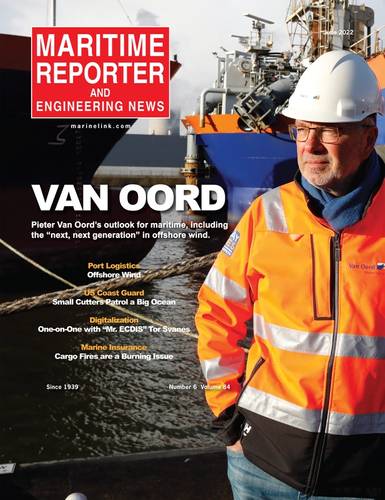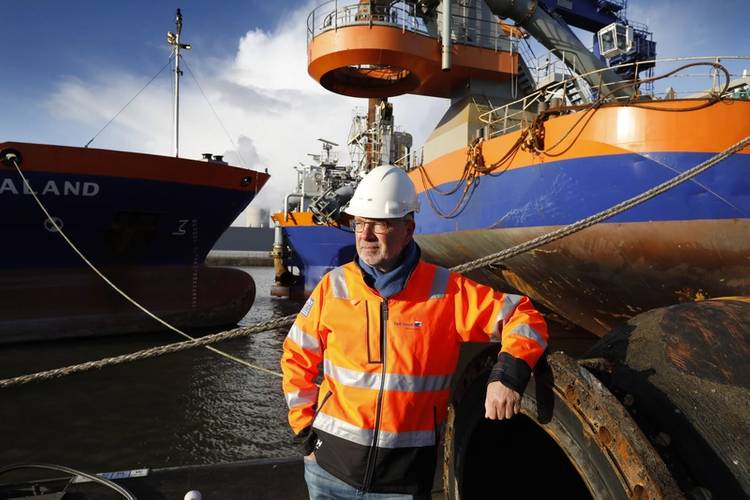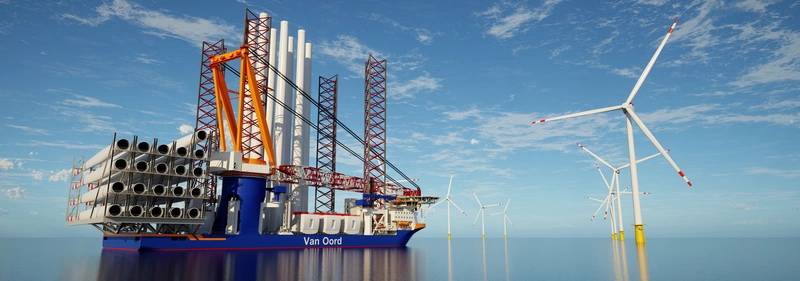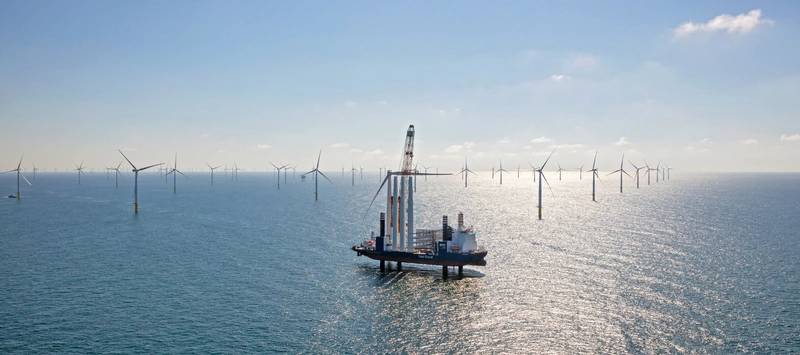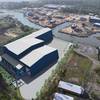VIDEO: One-on-One with Pieter van Oord, CEO, Van Oord
Pieter van Oord is candid in discussing the future growth of his storied company’s activities in offshore wind with specific insights on challenging current jobs, Van Oord’s recent order of a massive and groundbreaking Wind Turbine Installation Vessel, and the company’s future working in the United States.
- Pieter, to start, can you give a ‘By the Numbers’ look at your company today using the metrics of your choice?
Well, 2021 was a disappointing year for us. As we said in our annual report, it was ‘a year with two faces.’ We had to report a loss for the first time in a long time in our company; a loss which was created by large provisions we had to take on three projects, including two offshore wind projects. One is the Greater Changhua project in Taiwan for Ørsted. The other one is the Saint-Brieuc project in France for Iberdrola. I’ll explain in detail a little bit later.
On the other side of the coin, we finished 2021 with a 4.4 billion Euro orderbook, which is a record orderbook for our company.
So (today there is some) optimism about this coming decades. We clearly see that the tipping point in our industry happened somewhere in 2021. Clients are aware that there is going to be a shortage of vessels, there’s going to be a shortage of experienced contractors.
- Obviously, Van Oord serves several sectors. Can you give a brief breakdown of revenue by market sector, with specific insights on the cumulative contribution and the future growth that you see in offshore wind, as a whole?
In 2020 we had a turnover of 630 million Euro for offshore wind, and with that the offshore wind business was, for the first time in the history of the company, the largest activity in our company, larger than dredging.
We saw a downturn in wind figures to 350 million Euros in ‘21. But I dare to say that this was an incidental event, associated with the operational issues we had on two projects.
So what we see in ‘21 was that dredging was more than 700 million (Euros), offshore wind 350 million (Euros), traditional offshore oil and gas, 200 million (Euros), and our infrastructure business in the Netherlands was about 250 million (Euros).
If you look at the future, it is obvious that our (offshore) wind business will outpace all other businesses. So, we’re convinced that within wind, we’re going to see double digits growth figures in the entire industry.
The question is, who is going to build all these projects? Are there sufficient contractors prepared to take on all of these risks? I don’t know the answer at the moment, but we are predicting an unbalance between supply and demand during this decade.
- How big is your offshore wind order book today? What is the largest projects in your pipeline? And, can you share with me the projects that you’re tendering at the moment?
Our order book is about one and a half billion Euros, which is a record high order book for offshore wind. And by that, it’s actually larger than the order book for our dredging business.
The largest project in our order book, for offshore wind, is the Sofia project for RWE, which is a project built in the UK. It’s a massive 1.4 GW project, where we have the balance of planned for the foundations and the cables. That is the largest project in the order book.
If you ask me the projects we are tendering, I would say maybe 20 at this moment.
We are tendering now for projects in offshore wind projects in ‘24, ‘25, ‘26, ‘27, ‘28, even sometimes 2029. What we see is long lead times between tenders and the actual execution of the project. That is typical in offshore wind.
Usually, I would say you win a project in year one, and you execute a project in year three or year four. So, the work we’re tendering for, most of it now is ‘25, ‘26. We have a pretty good order book for ‘22, ‘23, ‘24 already. We’re tendering for only a few projects left in ‘24.
We recently announced that we are the preferred contractor on three large projects in Japan, which is a major step, for European contractors to go to Japan. These three contracts are not in our order book at the moment, but they have a value for us of more than a billion Euro. They are really large projects that will be built in ‘27, ‘28, ‘29 and 2030. So, there is a lead time of five years, tendering negotiations, getting your design ready, doing your engineering, doing your procurement, before you actually are going to install those projects.
Our focus is the North Sea/Europe, that is by far the largest market. Number two is the United States. We have one project in the United States at the moment, work on the South Fork project for Ørsted. Today we’re tendering at least five projects in the United States. Third, we’re looking at Japan.
Watch the full video intervie with Pieter van Oord, CEO, Van Oord
- You referenced it in our first question, but among other projects, you’ve been involved in the Saint-Brieuc project offshore wind offshore France. Can you talk about your role there, your innovative drilling technology that you deployed, as well as challenges faced and lessons learned from this project?
I dare to say that the Saint-Brieuc project is the most complex foundation contract on an offshore wind park ever. We’re looking at soil which is granite. For this particular project it is a jackets project, not a monopile. We drill three pin piles where we are going to fix the jackets. Those pin piles are drilled in holes that are, on average, 25 meters deep.
We have a very experienced drilling subcontractor, the Bauer company, from Southern Germany. They have a lot of experience with drilling, particularly in the Alps.
So as you drill in this rock, one of the challenges is to ensure that the holes do not collapse while you are drilling. You have to keep the holes open, so as you drill, you immediately save the drilling hole with a casing.
When you finalize your drill, you remove your drilling tool and insert a pin pile; a permanent pin pile which will stick a few meters out from the bottom of the sea.
You have to grout the pin pile to make it firm. So, we grout and then we retrieve the casing. When we leave, there are just three small pinnacles which stick out of the bottom.
Then the next campaign is, with a crane vessel, you place the jacket on top of the three pins sticking out of the sea bottom. It’s an extremely complex (process and) project, and we encountered major issues in ‘21 on the project.
There was opposition by the local fishermen. We encountered soil that was even more difficult than the client had told us. So, we had to adjust the drilling tools to make it more suitable for this particular rock. We had to do a drill bit conversion. We have restarted the project in early March and – ‘knock on wood’ – so far things are going pretty well.
- In another first, last year the Fryslan project was completed, the first time a wind farm of this size has ever been constructed by a lake. Can you discuss the challenges of working in a lake as compared to offshore North Sea?
I would say it’s more difficult. The main reason for that is the logistics of bringing in those massive turbines and monopiles on a lake is quite challenging.
Second, the traditional tool to build an offshore wind project on the sea is a wind turbine insulation vessel. But here on this lake the average water depth is about 15 feet. So, the standard means were not available.
So we built a modular barge we called the ‘barge soccer pitch,’ because it was as big as a soccer field, and we put a massive crane on the barge. (For a project like this you need to build) bespoke equipment, which requires a lot of engineering and ingenuity.
Overall it was an extremely successful project; we finished last year, and it’s been generating a lot of electricity for the province of Fryslan.
 Artist impression of the Borreas, currently under construction in China, expected for delivery in 2024. Image courtesy Van Oord
Artist impression of the Borreas, currently under construction in China, expected for delivery in 2024. Image courtesy Van Oord
- Van Oord recently ordered a vessel that will be able to install turbines of up to 25MW, turbines that don’t exist today. Can you provide a rationale behind the decision to order that vessel?
Let me tell you a little bit about the history first. We built our first turbine installation vessel in 2002, a vessel called Jumping Jack, which has been sold.
In 2012, we contracted the vessel Aeolus, and it became operational in 2015. At that time, we were building turbines up to 4MW.
(At the time) we felt four megawatts was big because when we started in 2002, the average size of the turbines was two megawatts.
So between 2002 and 2014, the size (of the turbines doubled) from two megawatts to four megawatts. When we finalized our first project, which was the Gemini project, we suddenly realized that the average size of turbines had gone up to 8MW.
So we had to do a crane conversion on this vessel, installing a new Huisman crane, which made the vessel suitable for 10 to 11MW turbines.
Today, we’re in the midst of building 11MW turbines. But I can tell you, the Hollandse Kust Noord (HKN) project, which we are going to build for Shell, we’re going to see 14MW turbines.
So this coming winter, we’re going to do another crane conversion.
This is a long introduction to the story, and it’s why we believe that when you build a wind turbine installation vessel, you should actually keep in mind not the next generation turbine, but the next, next generation turbine.
We believe that somewhere around 2035 ... and this is obviously the feedback we have from the people like Siemens, Gamesa, Vestas and GE, that around 2035, we’ll be working with a 20MW turbine.
So we contracted this vessel and we put on a crane, with a vision that by 2035, we would be completely ready with this vessel, to build this generation (of wind turbines which today) does not exist.
It’s the largest turbine installation vessel in the world. But we really believe, if you want to invest for more than 10 years, there is no other choice.
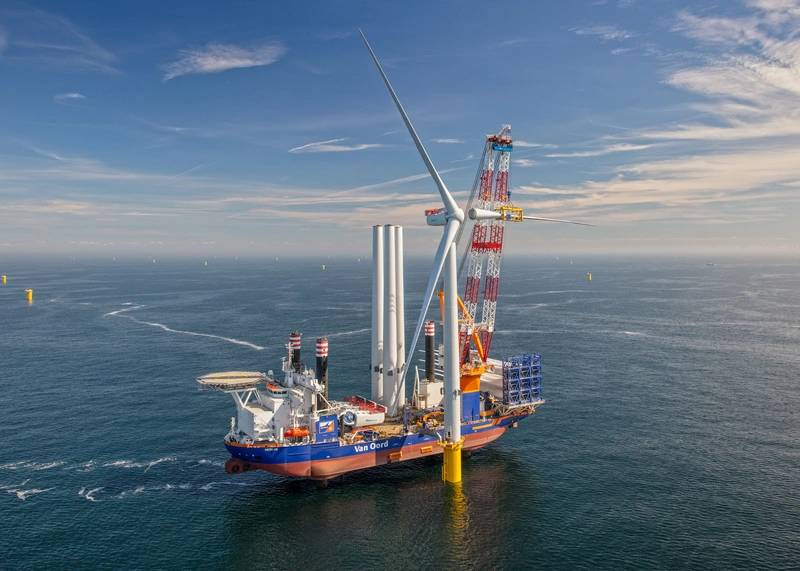 "In 2012, we contracted the vessel Aeolus, and it became operational in 2015. At that time, we were building turbines up to 4MW.
"In 2012, we contracted the vessel Aeolus, and it became operational in 2015. At that time, we were building turbines up to 4MW.
(At the time) we felt four megawatts was big because when we started in 2002, the average size of the turbines was two megawatts.
So between 2002 and 2014, the size (of the turbines doubled) from two megawatts to four megawatts. When we finalized our first project, which was the Gemini project, we suddenly realized that the average size of turbines had gone up to 8MW." Image courtesy Van Oord
- We also noted that the giant WTIV that you’re going to be building is able to run on methanol. Can you discuss how the decarbonization trend is driving decisions on the equipment that you build, own and operate?
This company has made a pledge that by 2050, in line with the Paris Agreement, we will be carbon neutral. That means that we only have 28 years to go.
Obviously the key emission within our company is the emission from the engines on our vessels. That means that we have to make two choices.
One, we have to choose the type of engine suitable for lower emission fuels or E-fuels. Two, we have to make a decision, with respect to choice of fuel, and the jury is still out. We don’t know whether it’s going to be methanol, ammonia. It could be hydrogen.
We have just finalized a series of three dredgers running on LNG. Where the footprint of LNG is much better than marine fuel, marine diesel, we see LNG as a transition fuel.
With respect to offshore wind, we see that our customers are extremely motivated to contract with contractors with a low emission solution.
For that reason we have chosen – on both vessels we’re building at this moment, a new cable-laying vessel, Calypso, which we have contracted with Vard; and the Boreas (WTIV) which we have contracted with Yantai Raffles – both vessels have engine types suitable for E-fuels.
So you make an extra investment to make those vessels able to run on those E-fuels.
With respect to the Boreas, particularly, we have made a decision that we’re going to make her dual fuel and suitable for methanol. Obviously, green methanol is, at the moment, only limited available. But we expect that between now and 2030, that a large infrastructure of green methanol will be built. We also have fuel tanks for green methanol built in the vessel.
With respect to the Calypso, we have the engines suitable for E-fuels. On this we will wait on the decision on what type of fuel we’re going to use.
One other fuel I’ve not yet mentioned is biofuels. On our present dredgers, which have traditional engines, we carry out more and more projects with biofuels.
We have a number of people around here, in Northwest Europe now, who produce biofuels. Neste, from Finland, for example, is a big player in biofuels.
Shell Oil has just made an announcement that they’re going to build here in Rotterdam, at the largest refinery, also a large biofuel factory.
In the future I would say fuel technology, on the one hand, phasing out marine diesel with the existing engines, with biofuels. On the other hand, new vessels, making them suitable for the E-fuels. Whether it be ammonia or methanol, I don’t know, but I think that will be our future.
- When you look ahead to the coming generation, what do you see as the greatest challenge for maritime companies of your shape and size to survive, to prosper? How are you investing today to ensure your tomorrow?
We’re living in a time of transition, and you only survive when you adapt. There is a lot of uncertainty in the market (regarding the) direction we’re going. But it’s clear that, driven by the Paris Agreement, we have to move to carbon neutrality. That’s going to change the entire industry. I think what it means, is that we have to phase out all vessels; we have to build new vessels.
What is the largest challenge? I would say it’s a cultural challenge. That mindset of your people needs to change.
We cannot continue the way we have in the past. We need to build new vessels, which (today) is quite a challenge, because new build prices have gone up considerably, and you need to find a proper shipyards to build your new vessels. I expect in the next decades a massive wave of investments in all sorts of new vessels, whether it be container vessels, bulkers, tankers, dredgers, wind turbine installation vessels, which are suitable for this carbon neutral era.
- Okay. Pieter, I truly appreciate your time. I look forward to following the Van Oord story for another 30 years.
Well, and we’re moving (more) to the United States. Follow the news. In the near future, we’re going to do more announcements about the United States.
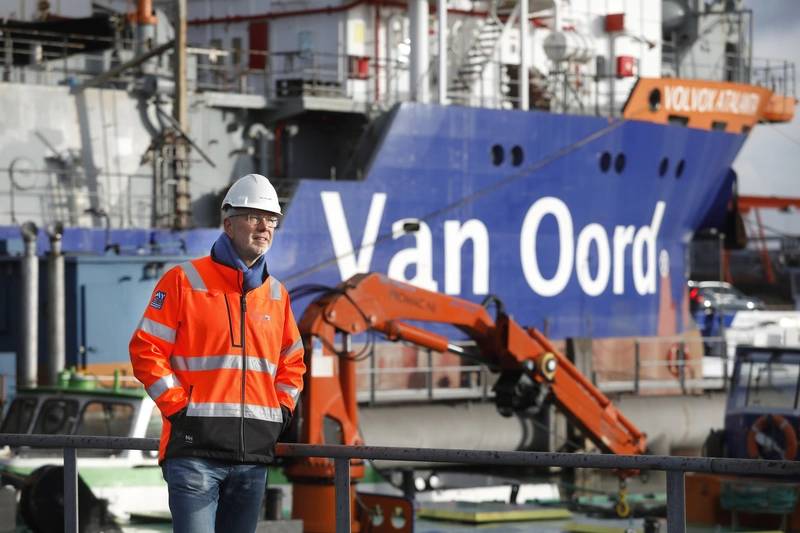 “I expect in the next decades a massive wave of investments in all sorts of new vessels.”
“I expect in the next decades a massive wave of investments in all sorts of new vessels.”
Pieter van Oord, CEO, Van Oord








